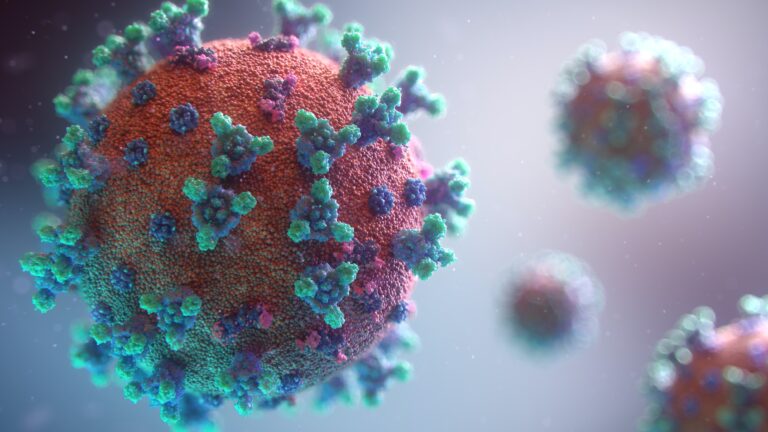Our project on SARS-CoV-2 was highlighted by EuroCC. Read the original post and the interview at EuroCC website.
Portuguese researchers discovered promising molecules to develop optimized drugs against COVID-19
200 thousand molecules were tested using advanced computing. Researchers found two with good capacity to inhibit the virus and covered them with patents. So far, everything indicates that they are effective in combating new variants.
November 2019. Wuhan, China. The first confirmed case of Covid-19 is announced. March 2020. Porto, Portugal. The media reported that there was one infected and another one being evaluated. From then on, everyday life, life as we knew it, changed – until today.
The first data from a study released by the National Institute of Health Doutor Ricardo Jorge showed that a variant of SARS-CoV-2 with a specific mutation in a protein – dominated the early scenario of national infections. All over the world, research lines were multiplying, focusing on the Spike protein, which had proven to be essential for the virus to successfully infect human cells.
Every little piece of information about it served to help Sérgio Sousa and his team from the BioSIM laboratory, who, from the very beginning, were called to this fight to develop drugs that could prevent the infection. The work started right in the same month that in the world – and in the country – cases after cases were confirmed. “At the time, we were approached by Crowd Fight for Covid, a collaborative platform of scientists around the world, and we were asked to join a network of researchers with experimental techniques already capable of doing certain tests to evaluate the mechanisms of virus propagation,” says the researcher.
Without hesitation, the Portuguese group rolled up their sleeves and embarked on the challenge. It was up to them to find, through computational resources, molecules with “inhibitory” capacity, in other words, to prevent the spread of the virus.
“WE TESTED ABOUT 200 THOUSAND MOLECULES TO TRY TO CHOOSE A SET OF THEM THAT COULD LATER BE TESTED EXPERIMENTALLY”
Computing at science’s service
According to Sérgio Sousa, the Spike protein of SARS-CoV-2 is “an essential part for the virus to be able to infect human cells”. “It is a kind of spike that exists on the surface of the virus, which interacts with the ACE2 receptors of human cells, present in lung cells” he explains, adding that it’s like there is a “recognition” between both of them.
To design drugs that can prevent this interaction between the virus protein and the human one, the BioSIM group started by creating a “three-dimensional model” of this process, using computational resources of the National Distributed Computing Infrastructure. They built it “atomic-scale”, using “crystallographic structures” that had already been published by other scientists, and simulated such recognition. They did this through Graphical Processing Units – better known as GPUs – which, as the researcher explains, “are popularly used to allow a better visualization of graphics”, as happens, for example, in computer games. In Sérgio Sousa’s research, they were used to “study systems with several hundred thousand atoms, to understand how different proteins interact with each other. In this specific case, to study how molecular recognition occurs between the Spike protein of the virus and the ACE2 receptors.

The three-dimensional model served as the basis for testing a large number of molecules collected from “virtual libraries” that can be purchased, to see if any could prevent the virus from infecting human cells. “We tested about 200 thousand molecules, to try to choose a set of them that could later be tested experimentally,” says Sérgio Sousa. From this list of molecules, it was important to find out if they could bind to this Spike-ACE2 complex (and stay there) and how strong this association was. To do this, they used Central Processing Units (or CPUs) that are typically found in computers and, although less powerful than GPUs, were extremely important to test the huge database of molecules. It was through the CPUs that it became possible to “assess, in atomic detail, the ability of each one to block or limit recognition between the two proteins,” he says.
“These computational resources allowed us to make a sort of ranking of molecules, from the least to the most promising,” he explains. “If we didn’t have access to them, we would have tested a much smaller number of these molecules and it would mean much less chance of success”.
“SMALL, ALMOST SURGICAL CHANGES WERE MADE TO THEM SO THAT THEY ORIGINATE MORE SPECIFIC DRUGS, WITH FEWER SIDE EFFECTS, GREATER AFFINITY, AND TO CIRCULATE BETTER IN OUR ORGANISM,”
From theory to practice
Once the molecules that presented the greatest potential – between 20 and 30 – had been collected, the information was made available to other groups that collaborated with the laboratory. They purchased those molecules and tested them in two different ways: in vitro and in cellular models. “If they actually had interesting inhibitory activity in these models, these molecules would be optimized,” says the researcher.
The results were indeed encouraging: two of the molecules were covered by patents and subsequently improved. Small, almost surgical changes were made to them so that they originate more specific drugs, with fewer side effects, greater affinity, and to circulate better in our organism,” he adds.
The next step – and the one the team is currently in – is testing the different variants of SARS-CoV-2 that have emerged, with the goal of “ensuring that these new molecules – and potential drugs – under development, maintain their activity,” he explains. “For now, our results say yes,” he says.
If these suspicions are confirmed, animal trials are close at hand and, with hope and ambition still contained, the clinical ones may also be around the corner.
This work was produced with the support of INCD funded by FCT andFEDER under the project 01/SAICT/2016 nº 022153
